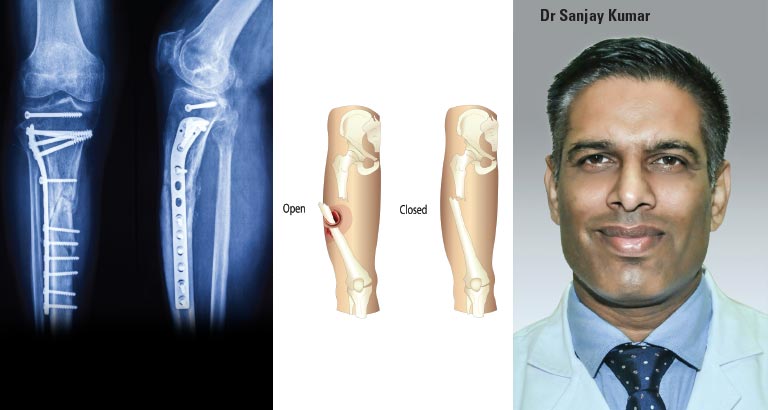
Dr Sanjay Kumar, orthopaedic surgery specialist at Bahrain Specialist Hospital (BSH), explains advanced fracture management for open fractures and trauma.
What is an open fracture?
Fractures where the broken bone protrudes through the skin or communicates with a wound are termed ‘open’ or compound fractures. Exposure of the fracture to the external environment produces local contamination and increases the risk of significant infection. Open fractures are considered a surgical emergency.
Are all open fractures the same?
The severity of open fractures can vary significantly. The degree of injury and complexity of the treatment is influenced by a series of factors such as:
• Energy of injury (height of fall, speed of car accident).
• Degree of contamination (soil, broken glass, stagnant water).
• Degree of injury to the soft tissues (crushed/avulsed – where the tissue is pulled away from its normal anchor).
• Severity of the fracture pattern (number of
bony fragments).
• Any injury to blood vessels.
Open fractures are split into different categories depending on the above factors (known as Gustilo classification). This rating system rapidly describes the degree of injury, risk of complications and need for plastic surgery and vascular surgery intervention to save the extremity.
How are open fractures treated?
The initial evaluation and treatment of open fractures is best performed at a centre equipped for the task, such as BSH. These fractures are often associated with motor vehicle accidents, industrial accidents, falls and gunshot wounds. Up to one third of individuals will have other life-threatening injuries along with the complicated fracture.
Following initial stabilisation and a thorough search for additional injuries, an individual with an open fracture will receive tetanus prophylaxis, intravenous antibiotics and a temporary splint. Open fractures are considered a surgical emergency. Every effort is made to obtain formal surgical treatment in a timely fashion to reduce the risk of infection.
In the operating room, the surgeon will remove debris, foreign bodies, soil, dead soft tissue and loose fragments of bone – this is known as surgical debridement. The wound and fracture are washed with large volumes of sterile fluid, often containing antibiotics.
After decontaminating the wound, the orthopaedic surgeon will stabilise the fracture, which can be achieved via internal methods with plates/rods or with an external frame made of a series of wires, pins and tubes. If the associated wound is small it will be closed with sutures and the patient will receive intravenous antibiotics.
What happens if large areas of skin and muscle are damaged or missing?
After thorough cleansing and fracture stabilisation, the surgeon may be left with a large, complex wound that cannot be directly brought together with sutures. Plastic surgery techniques will be required to close or cover the wound immediately after fracture fixation or later once the wound is clean.



